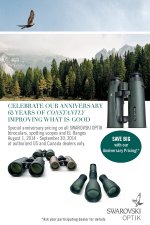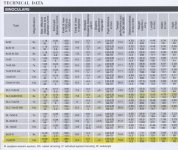Of course not, at least for birding, because almost nobody "needs" to even be a birder.
Birding skill is more important than bins for sure. You reference a big sit, but the difference is even more substantial when you set birders to "cover" an unfamiliar area during a count. Being a really great birder is also (and in large measure) about "reading" the landscape (habitat) and thus being able to find the rarities within it. That said, the best birders I know (who are as accomplished as I can imagine is humanly possible with vocal ID etc) have pretty darn good to superb binoculars, and they benefit from them. I'm sure your birder would too, unless he is already committed to a birding style where he excludes visual ID of any birds at what would be the limits.
I am quite sure that you are wrong. I am also quite sure that most birding, and certainly not the the best birding in my life, has not been under sunny skies. As someone who has spent a fair amount of time birding in the sunny deserts of Arabia, I can tell you that even under sunny skies, when the sun is overhead or in front of you, alpha bins with excellent contrast and color substantially outperform lesser bins. Under those conditions, with much grazing light and high contrast, it is as if many field marks disappear with cheap bins. Field marks are always handy, even when you know birds by other means.
Agreed, at least for those of us who don't make our living being the best bird guide or contract driver we can be.
That test doesn't prove that the bins are equivalent in performance, only that your testers aren't really pushing them to their limits.
I think your test would back-fire if done on a population who is optically savvy, be they hunters or birders. I have very high standards for the top makes, which is why I'm so often disappointed by their flaws (e.g. the astigmatism and blue-bias of the Zeiss FL series, the rolling ball and slow focus of the 8.5x42 Swarovision, the poor close focus, high CA, and narrower FOV of the full-sized Leica Ultravids). Those flaws are easily perceived, just as it is sometimes easy to pick out the lemon and cherry from a set of units of the same model (a _much_ harder task than simply overcoming label-induced bias in expectations). I don't think expectations ultimately have much effect on final assessment when you are dealing with a user who actually knows what they are looking for when testing a bin. Another point I'd make is that many of us optics nuts have a special fondness for budget models, so if anything, we are biased toward (and more forgiving of the flaws) loving "cheap" bins that perform well. I know I love my Browning 8x32 and my Nikon 8x30 EII (which each cost a little over $200).
As you know from our earlier conversations, I do drive a Honda Civic (1994 model). But that's because all I need a car to do is get me from point to point reliably and as cheaply as possible so I can use my uber-bins to see birds better than you think is necessary

--AP






